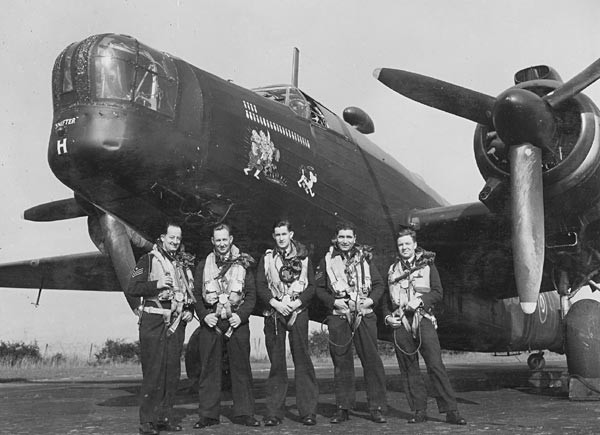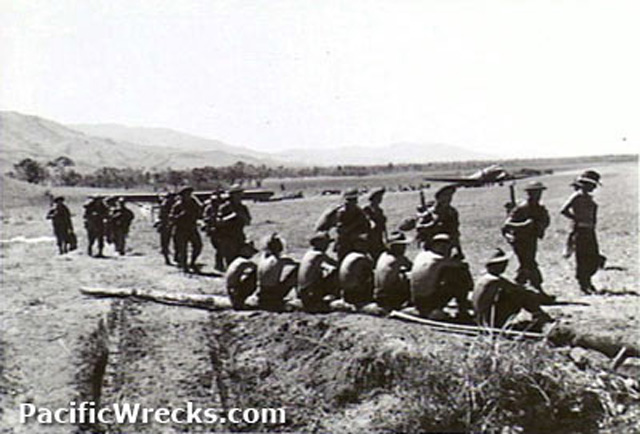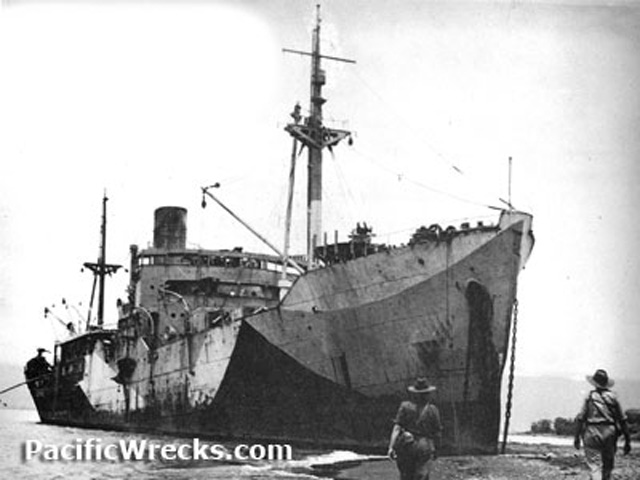Air Operations, Bismarcks
V Bomber Command B-25s attack antiaircraft batteries at Rein Bay.
[Air Operations, Europe
RAF BOMBER COMMANDEvening Ops:
- 8 Mosquitos are sent to Cologne and Düsseldorf, 10 Stirlings lay mines in the Frisians and there are 11 OTU sorties.
- There are no losses.
This Crew Has Completed the Required Number of Missions |
 |
FRANCE:
68 3rd Medium Bomb Wing B-26s attack the St.-Omer/Longuenesse Airdrome with 100 tons of bombs at 1718 hours.
US 12th AIR FORCEITALY:
- XII Bomber Command B-17s attack marshalling yards at Bologna and a rail bridge at Bolzano.
- XII Bomber Command B-25s and B-26s attack the Bastia/Borgo, Lucca, and Pisa Airdromes, a road junction, and several rail and road bridges.
- NATAF aircraft attack numerous tactical targets.
- In the first air-to-air engagements over Italy in a week, 1 31st Fighter Group Spitfire downs 1 FW-190 during the morning near Montecorvino Airdrome. 27th Fighter-Bomber Group A-36s down 3 Bf-100s around the Aquino Airdrome at 1220 hours.
Air Operations, New Guinea
- A total of approximately 40 V Bomber Command B-17s, B-24s, and B-25s attack defenses and lines of supply in the Bogadjim area.
- 3rd Light Bomb Group A-20s and RAAF bombers attack Japanese Army defenses near Finschhafen.
Air Operations, Solomons
- AirSols B-25s, TBFs, and SBDs attack gun emplacements at and near the Vila airfield at Kolombangara.
- A VF-12 F6F downs an A6M Zero over Barakoma, Vella Lavella, at 1113 hours.
Diplomatic Relations
A Lend-Lease agreement is signed by United States and Free French representatives at Algiers.
[Britain, Politics
There is a Cabinet reshuffle because of the death on September 23 of Sir Kingsley Wood, then Chancellor of the Exchequer. Atlee becomes Lord President of the Council, Sir John Anderson, Chancellor, Lord Cranbourne, Dominions Secretary and Lord Beaverbrook, Lord Privy Seal.
[Eastern Front
Stalin announces the greatest victory of the summer campaign. The Soviets take Smolensk and Roslavl
arguably their most important success since the end of the Kursk battle. Smolensk, with its vast network of defenses constructed by the Germans over 2 years and claimed by Berlin to be impregnable, was the keystone to the entire German defense system in Russia. The German 4th Army, which has been withdrawn west of Smolensk, withstands the powerful Russian thrust in the direction of the Orsha River. From here to the south the Germans are retreating behind the Dniepr, where they have been ordered to make a stand by Hitler. This retreat has been entirely forced and so there has been less benefit than if it had been done earlier as von Manstein recommended.
CENTRAL SECTORThe 31st, 5th and 68th Armies take Smolensk. Roslavl falls to the 10th Army.
SOUTHERN SECTORGerman forces continue to withdraw across the Dniepr, while the 7th Guards Army of the Steppe Front reaches it south of Kremenchug, crossing with ease.
[Italy
Gen Montgomery begins regrouping the British 8th Army to strengthen the eastern flank. The V Corps, which is to include the 5th, the 1st Airborne, and the Indian 8th Divisions, is initially to remain in the Taranto area while the XIII Corps, with the 78th Division on the right and the Canadian 1st Division on the left, continues its advance. The V Corps is later to move forward behind the XIII Corps and secure its left flank.
[Mediterranean
The US minesweeper Skill (AM-115) is sunk by U-593 in the Gulf of Salerno. Her sistership Speed (AM-116) rescues the survivors.
[New Guinea
The Australian 20th Bde advances slowly towards Finschhafen.
[North Sea
In a German minelaying operation off Harwich and Ordfordness by S-boats, the British minesweeping trawler Franc Tireur is sunk by S-96 off Harwich with the loss of 15 crewmen. S-96 is then rammed by ML-150 and ML-145 and abandoned. 13 German crewmen are picked up and made prisoners of war.
[Pacific
The US submarines Bowfin (SS-287), Billfish (SS-286) and Bonefish (SS-223) attack a Manila-bound convoy. Bowfin sinks the tanker Kirishima Maru (8120t) 220 miles north of Nha Trang, French Indochina.
[Solomons
The Japanese begin to evacuate Kolombangara. Their garrison there has been made useless by the American capture of the other islands in the New Georgia group. Over the next week 9,400 men are taken off by landing craft and destroyers. US destroyers sink 40 boats. 1,000 Japanese drown.
[Pics from September 25, 1943
|
|

